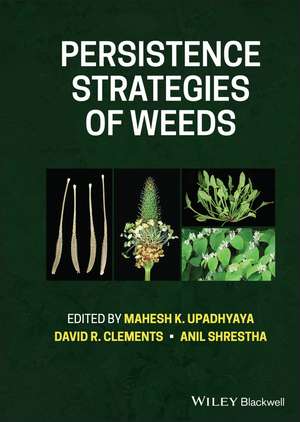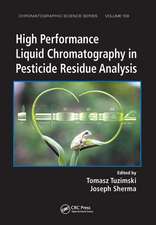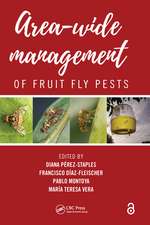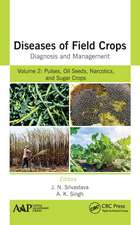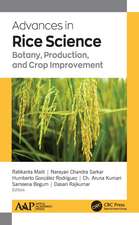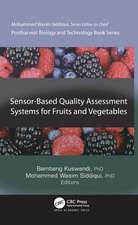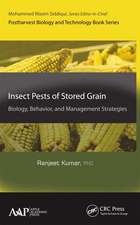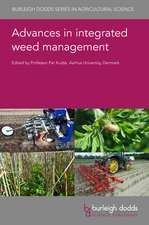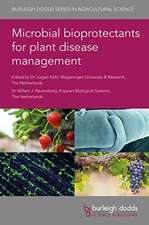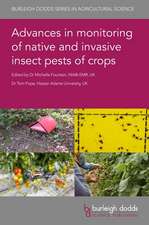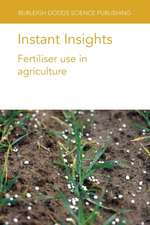Persistence Strategies of Weeds
Autor MK Upadhyayaen Limba Engleză Hardback – 9 mar 2022
An invaluable source of up-to-date information on all major aspects of weed persistence
Weeds negatively impact crop yields, the quality of agricultural produce, the health of livestock and ecosystems, and various aspects of human life. Despite significant expenditures of time, money, and resources by agricultural producers, land managers, and the general public, weeds persist. Developing new methods for protecting crops and the environment requires a thorough understanding of the persistence mechanisms of weeds.
In Persistence Strategies of Weeds, an international team of expert authors provide detailed information on weed seed biology, identify the vulnerabilities of different weeds, and address the underlying issues behind the problem of weed persistence despite various management methods including herbicides. Presenting a comprehensive approach to the subject, the authors describe what is already understood about weed persistence and what yet needs to be determined. Topics include the role of seed production, dissemination, seed banks, the physiology and genetics of seed dormancy, the influence of agronomic practices, seed longevity, vegetative propagation, allelopathy, predation, soil microbes, weed evolution, and more. This authoritative volume:
- Examines the genetic flexibility of weeds to adapt to changes in agricultural practices and management strategies
- Discusses the release of allelochemicals by certain weeds that inhibit the growth of competing plant species
- Explores the influence of climate change on weed persistence and how the efficacy of herbicides will be affected
- Emphasizes the importance of sustainable crop production and reducing dependence on synthetic herbicides
- Provides extensive coverage of the roles of genetic, environmental, and morphological factors in the regulation of weed seed dormancy
- Includes an overview of persistence strategies of weeds, detailed case studies, and numerous illustrative examples
Persistence Strategies of Weeds is an ideal textbook for all upper-level undergraduate and graduate students of weed and pest biology, agroecology, or organic agriculture, and a must-have reference for weed scientists and weed management professionals.
Preț: 1197.05 lei
Preț vechi: 1315.44 lei
-9% Nou
229.13€ • 248.97$ • 192.59£
Carte tipărită la comandă
Livrare economică 21 aprilie-05 mai
Specificații
ISBN-10: 1119525608
Pagini: 400
Dimensiuni: 171 x 253 x 25 mm
Greutate: 0.84 kg
Editura: Wiley
Locul publicării:Chichester, United Kingdom
Notă biografică
Mahesh K. Upadhyaya, Professor Emeritus, Applied Biology, Faculty of Land and Food Systems, University of British Columbia, Vancouver, BC, Canada David R. Clements, Professor, Biology and Assistant Dean, Faculty of Natural and Applied Sciences, Trinity Western University, Langley, BC, Canada Anil Shrestha, Professor, Weed Science and Chair, Dept. of Viticulture and Enology, California State University, Fresno, CA, USA
Cuprins
1 Persistence strategies of weeds: Introduction Anil Shrestha, David R. Clements, and Mahesh K. Upadhyaya 1.1 Introduction 1.2 Persistence of weeds 1.3 Current approaches to managing weeds and persistence 1.4 Conclusions 1.5 References 2 Seed production, dissemination, and weed seed banks Acácio Gonçalves Netto, Pedro Christoffoleti, Mark VanGessel, Saul Jorge Pinto de Carvalho, Marcelo Nicolai, and Caio Brunharo 2.1 Introduction 2.2 Seed production 2.3 Seed dissemination 2.4 Weed seedbank and seedbank dynamics 2.5 Weed management and seed banks 2.6 Use of chemicals to deplete soil seedbanks - Potential and limitations 2.7 Weed seed destruction or devitalization of seeds 2.8 Soil seed bank research methodology 2.9 Conclusions 2.10 References 3 Weed seed dormancy and persistence of weeds Mahesh K. Upadhyaya, Steve Adkins, and Li Ma 3.1 Introduction - Seed dormancy and persistence of weeds 3.2 Seed dormancy and germination 3.3 Types of seed dormancy and some terminology 3.4 Dormancy polymorphism 3.5 Mechanisms of seed dormancy 3.6 Co-adaptation of seed dormancy and hormonal regulation of seed reserve mobilization 3.7 Duration of seed dormancy and depletion of seed banks during summer-fallow 3.8 Dormancy cycling 3.9 Conclusions 3.10 References 4 Seed dormancy genes and their associated adaptive traits underlie weed persistence: A case study in weedy rice Xing-You Gu 4.1 Introduction 4.2 Weedy rice 4.3 Genetics of primary seed dormancy 4.4 Genes/QTLs responsible for associations of wild-like traits with seed dormancy 4.5 Genes/QTLs responsible for associations of crop-mimic traits with seed dormancy 4.6 Conclusions and implications 4.7 References 5 Environmental regulation of weed seed banks and seedling emergence Roberto L. Benech-Arnold and Diego Batlla 5.1 Introduction 5.2 Germination 5.3 Predation 5.4 Loss of viability as a result of physiological deterioration 5.5 Dormancy in seed banks and its control by the environment 5.6 Germination as affected by temperature and water availability 5.7 The functional ecology of weed seed banks: concluding remarks 5.8 References 6 Longevity of weed seeds in seedbanks Ali A. Bajwa, Fernanda C. Beveridge, Mahesh Upadhyaya, and Steve W. Adkins 6.1 Introduction 6.2 Seeds and seedbanks as survival mechanisms 6.3 Role of seed longevity in seedbank regulation 6.4 Classical ecological experiments on weed seed longevity 6.5 Factors affecting weed seed longevity 6.6 Implications of seedbank longevity for weed management 6.7 Conclusions and future research directions 6.8 References 7 Evolution and persistence of herbicide-resistance of weeds Hugh J. Beckie, Linda M. Hall, Roberto Busi, and Michael B. Ashworth 7.1 Introduction 7.2 How evolution of herbicide resistance influences persistence of weed populations 7.3 Case studies 7.4 Conclusion 7.5 References 8 Seed predation and weed seed banks Pavel Saska and Alois Honik 8.1 Introduction 8.2 Predators and seed predation windows in the life cycle of a weed 8.3 Seed defence versus seed selection by predators 8.4 Spatio-temporal variation in seed predation 8.5 The significance of seed predation for the population dynamics of weeds 8.6 Field and crop management effects on weed seed predation 8.7 Methodological aspects of studying seed predation 8.8 Directions for future research and conclusions 8.9 References 9 Modelling the persistence of weed populations Jonathan Storkey, Antoine Gardarin, Nathalie Colbach, Helen Metcalfe, and Alice Milne 9.1. Why do we need models to predict weed persistence? 9.2 'Broad-brush' ecological approaches to modelling weed persistence 9.3 A process-based approach to modelling weed persistence 9.4 Integrating seedbank processes into the multi-annual weed dynamics model 9.5 The weed seed traits selected by management practices 9.6 Conclusions 9.7 References 10 Influence of agronomic practices on the persistence of weed seedbanks Clarence Swanton and Saeed Vazan 10.1 Introduction 10.2 Tillage: Vertical distribution of seeds within the weed seedbank influences weed seed persistence 10.3 Light penetration and soil disturbance can reduce seed persistence 10.4 Diverse crop rotations do not consistently reduce weed persistence 10.5 Control of weed seed at harvest has potential to reduce seed persistence 10.6 Role of cover crops and microbial populations 10.7 Livestock, pasture and manure management can reduce weed seed persistence 10.8 Conclusions 10.9 References 11 Clonal growth, resprouting, and vegetative propagation of weeds Jitka Klimesová and Jana Martínková 11.1 Introduction 11.2 Weeding as a disturbance regime 11.3 Plant strategies under recurrent disturbance 11.4 Plant traits typical for tolerance strategies and resprouting limitations 11.5 Tolerance strategy in an evolutionary perspective 11.6 Conclusions 11.7 References 12 Climate change and the persistence of weeds David R. Clements and Antonio DiTommaso 12.1 Introduction 12.2 Weed ecophysiological responses to climate change 12.3 Predicted changes in weed distribution 12.4 Impacts of climate change on weed interactions with crops 12.5 Evolutionary impacts of climate change on weeds 12.6 Conclusions 12.7 References 13 Soil microbial effects on weed seed bank persistence: current knowledge and applications for weed management Markus Wagner and Nadine Mitschunas 13.1 Introduction 13.2 Mechanisms of microbial attack 13.3 Abiotic environmental factors 13.4 Biotic interactions 13.5 Seed defences 13.6 Weed management applications 13.7 Future Prospects 13.8 References 14 The potential role of allelopathy in the persistence of invasive weeds Sajid Latif, Saliya Gurusinghe, and Leslie A. Weston 14.1 Introduction 14.2 Classification of allelochemicals 14.3 Allelochemical modes of action 14.4 Synthesis, localization and release of allelochemicals from donor plants 14.5 Factors affecting biosynthesis and release of allelochemicals 14.6 The role of soil microorganisms in the release and transformation of allelochemicals 14.7 Metabolic profiling of allelochemicals 14.8 Case studies of invasive plant species exhibiting allelopathic interactions 14.9 Conclusions 14.10 References 15 Weed adaptation as a driving force for weed persistence in agroecosystems Paul Neve and Ana L. Caicedo 15.1 Introduction 15.2 Modes of weed evolution 15.3 The genetic basis of phenotypic variation in weedy and fitness-related traits 15.4 The contemporary evolution of weeds in agroecosystems: evidence and case-studies 15.5 Applying evolutionary thinking to weed biology and management 15.6 Weed adaptation: a key determinant of weed persistence in agroecosystems 15.7 References 16 Persistence strategies of weeds: Synopsis and the future Mahesh K. Upadhyaya, David R. Clements, and Anil Shrestha 16.1 Introduction 16.2 Weed propagation, dissemination and seed propagule banks 16.3 Weed seed dormancy and longevity 16.4 Agronomic practices 16.5 Predation, microbial effects, and allelopathy 16.6 Climate change and environmental influences 16.7 Weed adaptation and evolution and persistence of herbicide-resistant weeds 16.8 Modelling the persistence of weed populations 16.9 Conclusions 16.10 References Index
